- Toddler Measles Symptoms
- Toddler Flu Treatment
- Toddler Flu Symptoms
- Toddler Stomach Flu Symptoms
- Toddler Hair Loss
- Toddler Urinary Tract Infection Symptoms
- Toddler Tonsillectomy Recovery
- Toddler Periorbital Cellulitis
- Toddler Vomiting and Diarrhea
- Types of Toddler Vomiting
- Toddler Vomiting Treatment
- Toddler Cough Vomit
- Toddler Dandruff
- Toddler Bowlegs
- Toddler Eye Infection
- Toddler Pink Eye
- Toddler Pink Eye Symptoms
- Toddler Eye Problems
- Toddler Hearing Loss Signs
- Symptoms Of Pinworms In Toddlers
- Toddler Blood Infection
- Toddler Mononucleosis
- Toddler Motion Sickness
- Toddler Labial Adhesion
- Lyumphoma in Toddlers
- Toddler Scabies
- Toddler Pinworms
- Toddler Insect Bites
- Toddler Meningitis
- Toddler Moles
- Toddler Lyme Disease
- Toddler Nosebleeds
- Toddler Ingrown Toenail
- Toddler Lead Poisoning
- Toddler Hair Loss Alopecia Areata
- Toddler Heat Stroke
- Toddler Rubella
- Toddler Tonsillectomy
- Toddler Iron-Deficiency Anemia
- Toddler Tooth Discoloration
- Toddler Concussion
- Toddler Psoriasis
- Toddler Sunburn
- Toddler Tongue Blisters
- Toddler Impetigo
- Toddler Blepharitis
- Toddler Burns
- Toddler Burn Treatment
- Toddler Eczema Face
- Toddler Eczema Symptoms
- Toddler Urinary Tract Infection
- Toddler Boy Urinary Tract Infection
- Toddler Epilepsy
- Toddler Epilepsy Symptoms
- Toddler Walking Pneumonia
- Toddler Yeast Infection Symptoms
- Toddler Frostbite
- Toddler Hand Foot And Mouth Disease
- Toddler Dry Scalp
- Toddler Dry Skin
- Toddler Strep Throat
- Toddler Strep Throat Symptoms
- Toddler Sore Throat
- Toddler Mumps
- Toddler Bacterial Infection
- Shaken Baby Syndrome
- Shaken Baby Syndrome Symptoms
- Toddler Tonsillitis
- Toddler Eye Discharge
- Toddler Fifth Disease
- Toddler Febrile Seizures
- Toddler Food Poisoning
- Toddler Stomach Ache
- Toddler Warts
- Toddler Tuberculosis
- Toddler Torticollis
- Toddler Tick Bites
- Toddler Ear Infection Remedies
- Toddler Ear Infection Symptoms
- Toddler Ear Infection Signs
- Toddler Concussion Signs
- Toddler Bronchitis
- Toddler Colds
- Toddler Chicken Pox
- Toddler Appendicitis
- Toddler Asthma
- Toddler Birthmarks
- Toddler Strabismus
- Toddler Wheezing
- Toddler Sprains
- Toddlers Tinea Versicolor
- Toddler Viral Infection
- Toddler Yeast Infection
- Toddler Hives
- Toddler Canker Sores
Signs and Home Remedies for Gingivostomatitis In Toddlers
Gingivostomatitis is a condition in which a toddler develops ulcers, blisters and lesions in the mouth. The pain varies from one child to another and also depends on the severity of the infection.
Gingivostomatitis in toddlers is the result of a viral infection, mostly caused by the type 1 herpes simplex virus which affects a person in their childhood and remains dormant in them for the rest of their life. In a few cases, the infection may also be caused by the coxsakie virus.
Symptoms of Gingivostomatitis in Toddlers
Symptoms of Gingivostomatitis in Toddlers
The most obvious symptoms of toddler gingivostomatitis is the appearance of small sores inside the mouth that are red around the edges and pale gray or yellow in the centre. The sores may spread from the lips to the gums, palate, tongue, inner walls of the cheeks and even the tonsils, causing considerable pain, discomfort and even occasional bleeding. Secondary symptoms include rise in the body temperature, loss of appetite, bad breath and irritability in the child. The lymph nodes in the neck may also get inflamed and make it difficult for the child to swallow food and drink. Generally, the body's natural immune system heals the infection naturally within a week so there is no cause of worry.
Home Remedies for Gingivostomatitis in Toddlers
However, you may follow a few simple home remedies to bring some relief from the uncomfortable symptoms of this condition. Gingivostomatitis often leads to dehydration in toddlers as they find it difficult to eat or drink anything in this condition. Thus, it is advisable that you feed your child plenty of water and fruit juices and non-carbonated drinks like milkshakes.
You can also make the child suck a candy or frozen pops as this brings relief from the pain and swelling caused by the mouth sores. Feed the child food that does not require much chewing, such as mashed potatoes, yoghurt and boiled vegetables. This not only relives the irritation in the mouth and throat but also ensures that the child does not suffer from a deficiency of essential nutrients.
Also, make sure that your child maintains proper oral hygiene by washing his/her mouth thoroughly with mouthwash after every meal. This helps to prevent additional infection caused by bacteria that might make the symptoms even more painful. If the pain gets excessive, make the child gargle with a glass of warm water to which a pinch of salt has been added. By way of prevention, you should keep your child from coming into close physical contact with those who are already suffering from viral infections.


